|
|
|
Sort Order |
|
|
|
Items / Page
|
|
|
|
|
|
|
| Srl | Item |
| 1 |
ID:
140085
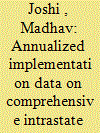

|
|
|
|
|
| Summary/Abstract |
This article introduces the Peace Accords Matrix Implementation Dataset (PAM_ID). We present time-series data on the implementation of 51 provisions in 34 comprehensive peace agreements negotiated in civil wars since 1989. We follow the implementation process for up to ten years following the signing of each agreement. The data provide new insights into the types of provisions that are more or less likely to be implemented, how implementation processes unfold over time, how implementation processes relate to one another, and how implementation affects various post-accord outcomes. We outline our coding methodology and case selection, and examine descriptive statistics. We illustrate one potential use of the data by combining eight different provisions into a composite indicator of security sector reform (SSR). A survival analysis finds that implementing security sector reforms contributes to long-term conflict reduction not only between the parties to the accord but also between the government and other non-signatory groups in the same conflict.
|
|
|
|
|
|
|
|
|
|
|
|
|
|
|
|
| 2 |
ID:
140084
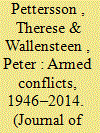

|
|
|
|
|
| Summary/Abstract |
In 2014, the Uppsala Conflict Data Program (UCDP) recorded 40 armed conflicts with a minimum of 25 battle-related deaths, up by six from 2013. This is the highest number of conflicts reported since 1999, and 11 of these conflicts were defined as wars, that is, conflicts generating 1,000 or more battle-related deaths in one calendar year. Further, an escalation of several conflicts, coupled with the extreme violence in Syria, resulted in the highest number of battle-related deaths in the post-1989 period. Yet, compared to the large-scale interstate wars of the 20th century, the number of fatalities caused by armed conflicts in 2014 was relatively low. Additionally, seven conflicts identified in 2013 were no longer active in 2014. However, four new conflicts erupted in 2014, all of them in Ukraine, and three previously registered conflicts were restarted by new actors. Furthermore, six conflicts reoccurred with previously registered actors. A positive development, however, is the increase to ten of the number of peace agreements concluded and signed in 2014, which represents a further four compared with 2013. And although this increase is part of a positive trend since 2011, it is worth noting that several peace processes remained fragile by the end of the year.
|
|
|
|
|
|
|
|
|
|
|
|
|
|
|
|
| 3 |
ID:
140082
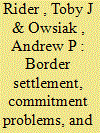

|
|
|
|
|
| Summary/Abstract |
Many studies have examined the formation of interstate rivalries, but few provide a theoretical mechanism capable of explaining why some neighboring states experience protracted conflict while others do not. To address this question, we theoretically link bargaining theories of conflict with issue-based explanations of conflict to offer a novel application of the commitment problem mechanism. We argue that when neighboring states disagree over border territory endowed with a potential source of power (i.e. strategic or economic value), it is difficult for either side to commit credibly in the future to comply with agreements made today. Consequently, neighboring states may be reluctant to make concessions that could enhance their adversary’s future bargaining power. This reluctance, in turn, increases the likelihood of bargaining failure, thereby also increasing the likelihood that the dispute festers and the relationship evolves into a rivalry. Using recently reported data on border settlement and three measures of rivalry, we find systematic evidence for our theoretical expectations. Unsettled borders increase the likelihood of rivalry onset. This relationship, however, seems driven by border territory containing strategic and economic endowments – the exact type of territory that theoretically drives commitment problems. We therefore conclude that not all territory matters for the onset of contiguous rivalries.
|
|
|
|
|
|
|
|
|
|
|
|
|
|
|
|
| 4 |
ID:
140076
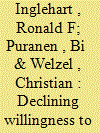

|
|
|
|
|
| Summary/Abstract |
The Democratic Peace thesis suggests that the absence of war between major powers since 1945 is caused by the spread of democracy. The Capitalist Peace thesis emphasizes trade and the rise of knowledge economies as the forces driving peace. Complementing these interpretations, we present empirical evidence of a cultural change that is making peace more desirable to the publics of most societies around the world. Analyzing public opinion data covering 90% of the world’s population over three decades, we demonstrate that improving existential conditions elevate the life opportunities of growing population segments and lead them to become increasingly tolerant of diversity and place growing emphasis on self-realization. In recognition of life’s rising opportunities, people’s valuation of life changes profoundly: readiness to sacrifice one’s life gives way to an increasing insistence on living it, and living it the way one chooses. Hence, pro-choice values rise at the same time as willingness to sacrifice lives in war dwindles. Historical learning based on the specific experiences of given societies has also changed their publics’ willingness to fight in wars. This transformation of worldviews places interstate peace on an increasingly solid mass basis.
|
|
|
|
|
|
|
|
|
|
|
|
|
|
|
|
| 5 |
ID:
140077
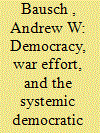

|
|
|
|
|
| Summary/Abstract |
This article uses an agent-based model and Selectorate Theory to explore the micro-foundations of the systemic democratic peace. Leaders engage in an international bargaining game that can escalate to conflict. Upon resolving the dispute, leaders distribute winnings to domestic constituencies and stand for reselection. The model’s assumptions about selectorate size in a democracy versus an autocracy make democratic leaders more accountable than autocrats and endogenously generates the dyadic democratic peace. The model shows no evidence of an autocratic peace, as mixed dyads are less likely to go to war than autocratic dyads. I further show that democratic leaders invest more resources in wars than predicted by the Nash equilibrium and also more than autocrats. This overinvestment by democratic leaders results in democracies winning more wars than autocrats. This model thus reinforces previous findings that democratic leaders respond to domestic reselection incentives by using more resources in conflict to gain a war-fighting advantage and help ensure victory. Finally, consistent with empirical results, I show that increasing the percentage of democracies in the system does not have a linear effect on the amount of conflict in the system. Below a certain threshold, increasing democracy has no effect on conflict, while after this threshold conflict decreases.
|
|
|
|
|
|
|
|
|
|
|
|
|
|
|
|
| 6 |
ID:
140078
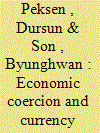

|
|
|
|
|
| Summary/Abstract |
Despite significant research on the efficacy and inadvertent humanitarian and political effects of economic sanctions, surprisingly little is known about the possible economic and financial consequences of sanctions for target economies. Synthesizing insights from the currency crisis literature with sanctions scholarship, we argue that economic sanctions are likely to trigger currency collapses, a major form of financial crisis that impedes economic growth and prosperity. We assert that economic coercion instigates currency crises by weakening the economy and creating political risks conducive to speculative attacks by currency traders. To substantiate the theoretical claims, we use time-series cross-national data for the 1970–2005 period. The results from the data analysis lend support for the hypothesis that sanctions undermine the financial stability of target countries. The findings also indicate that the adverse effect of economic coercion on the financial stability of target economies is likely to be conditioned by the severity of the coercion and the type of actors involved in the implementation of sanctions. The findings of this article add to the sanctions literature demonstrating how economic coercion could be detrimental to the target economy beyond the immediate effect on trade and investment. It also complements and adds to the literature on political economy of currency crises that has so far overlooked the significant role that economic coercion plays in financial crises.
|
|
|
|
|
|
|
|
|
|
|
|
|
|
|
|
| 7 |
ID:
140081
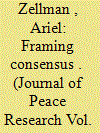

|
|
|
|
|
| Summary/Abstract |
International territorial conflicts are frequently characterized by political recourse to narratives of nationalist entitlement, stifling conflict resolution by raising domestic audience costs and discursively limiting bargaining flexibility. Conflict incentivizes elite employment of such claims precisely because security threats and fear of violence heighten popular resonance of adversarial collective identity frames. This article argues, however, that consensus mobilization behind nationalist territorial claims is highly dependent upon the particular narratives elites select to justify them. Employing controlled individual-level experiments administered to diverse populations in Israel, it demonstrates how exposure to competing narratives of homeland, security, economic prosperity, and settlement impacts support for control of East Jerusalem, the Golan Heights, and the West Bank. Although indivisible claims to ‘United Jerusalem’, the Golan, and West Bank settlement blocs and strategic highlands are generally considered popular consensus issues in Israel, only particular narratives trigger consensus mobilization behind each. Some narratives even encourage conciliatory policy attitudes against such appeals. As a democracy embroiled in multiple enduring territorial disputes, analysis of the Israeli case contributes to understanding of the limits and political consequences of elite rhetoric. Demonstrating the affinity between narrative frames and popular policy preferences, this article also lends insight into the intersubjective beliefs that drive mass support for nationalist territorial claims.
|
|
|
|
|
|
|
|
|
|
|
|
|
|
|
|
| 8 |
ID:
140080


|
|
|
|
|
| Summary/Abstract |
It is argued that threat related to territorial civil wars generates negative interpersonal attitudes that are both more intense and more broadly oriented than previously thought. That is, civil wars fought over issues of autonomy or secession foment social intolerance, a broad orientation that extends well beyond members of former enemy groups to an aversion to interpersonal differences in general. The expectation that the issue the civil war is fought over is consequential is tested with data from the World Values Survey and the UCDP/PRIO Armed Conflict Dataset. The empirical domain consists of over 130,000 individuals across 123 surveys in 69 countries over the 1989–2008 period. Results from multilevel models indicate a positive and statistically significant relationship between domestic territorial conflicts and subsequent social intolerance. Substantively, territorial civil wars have a far greater impact on individuals’ attitudes than do ‘standard’ correlates of social intolerance that are well established in the literature. Further, non-territorial civil war is unrelated to attitudes of social intolerance. Empirical results are robust to several model specifications and are not a mere artifact of the potential reverse relationship, whereby intolerant societies are (erroneously) presumed to be at a higher risk of civil wars in the first place. The findings have implications for the understanding of civil war resolution, civil war reoccurrence, and the contextual correlates of interpersonal intolerance.
|
|
|
|
|
|
|
|
|
|
|
|
|
|
|
|
| 9 |
ID:
140079


|
|
|
|
|
| Summary/Abstract |
Structural theories of international peace among democratic regimes have relied on two distinct explanatory logics: democratic institutions may cause a state’s foreign policy to tend toward peace by exposing policymaking elites to pressure from ordinary citizens (the popular logic) or to pressure from other governmental agencies (the elite logic). These logics are often conflated in scholarly studies of war and peace, but we attempt to isolate the popular logic for empirical testing by developing a novel measure of institutionalized popular influence, the Institutional Democracy Index (IDI). Whereas previous usage of the Polity index to operationalize democratic structures has succeeded in testing the elite logic more than the popular logic, we use the IDI to analyze long-established democracies’ involvement in international conflict between 1961 and 2001. What we find are significant differences within the family of democratic regimes that point to a monadic structural explanation of peace: more popular democracies are less warlike with respect to all other regimes, not just other democracies. By capturing variance among democratic regimes in their structures of inclusion (especially formal rules pertaining to voter access, electoral formulae, and cameral structures), the IDI enables us to observe crucial differences between the conflict propensities of more popular and more elite types of democracy.
|
|
|
|
|
|
|
|
|
|
|
|
|
|
|
|
| 10 |
ID:
140083


|
|
|
|
|
| Summary/Abstract |
Many international interactions are structured like a prisoner’s dilemma because there are incentives to cooperate but also incentives to defect. In an infinitely repeated prisoner dilemma interaction, valuing the future highly enough by discounting the future less can ensure cooperation. Another factor that affects international cooperation in an infinitely repeated prisoner’s dilemma interaction is how quickly actors can respond to defection with retaliation, in other words, the speed of retaliation. Speeding up retaliation to ensure cooperation is an attractive strategy because it is flexible. It can be adapted to the particular characteristics of a dyad of cooperation and can vary with different actors and even different forms of cooperation between the same two actors. An analysis of an infinitely repeated prisoner’s dilemma interaction shows that if speeding up retaliation is costless, payoffs are constant in time, and the temptation payoff is reduced in proportion to the speed-up of retaliation, then no matter how unfavorable the starting discount factor and unfavorable the payoffs, speeding up retaliation can make cooperation sustainable. This, in combination with its inherent flexibility, makes speeding up retaliation a potentially powerful tool to make cooperation sustainable. Because speeding up retaliation likely has some implementation costs and because prisoner dilemma payoffs may not be constant/even in time, there are limits on when speeding up retaliation is effective. However, the analysis shows that if implementation costs are not too high, payoffs are not too uneven, or, if uneven in a particularly unfavorable way, punishment, when inflicted, is sufficiently punishing, then speeding up retaliation can still be effective in ensuring sustained cooperation.
|
|
|
|
|
|
|
|
|
|
|
|
|
|
|
|
|
|
|
|
|